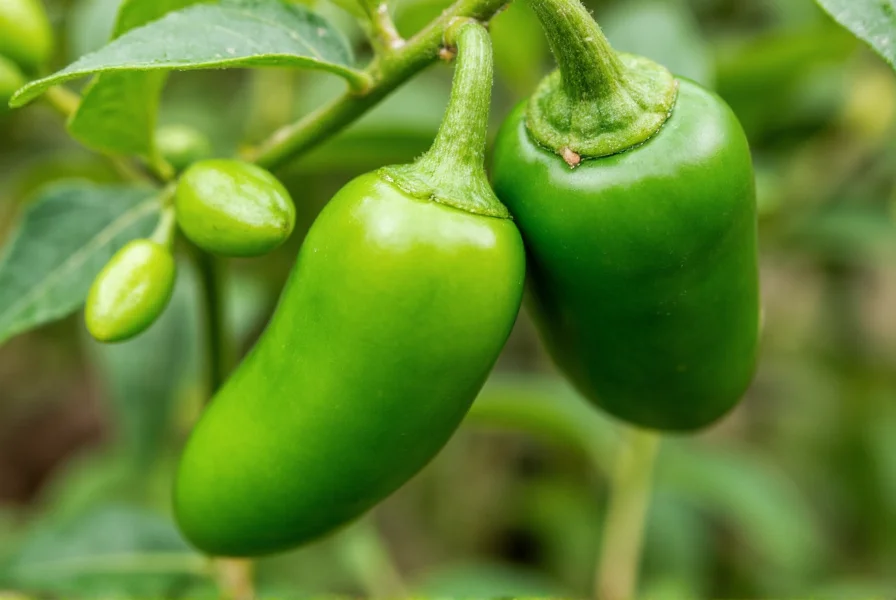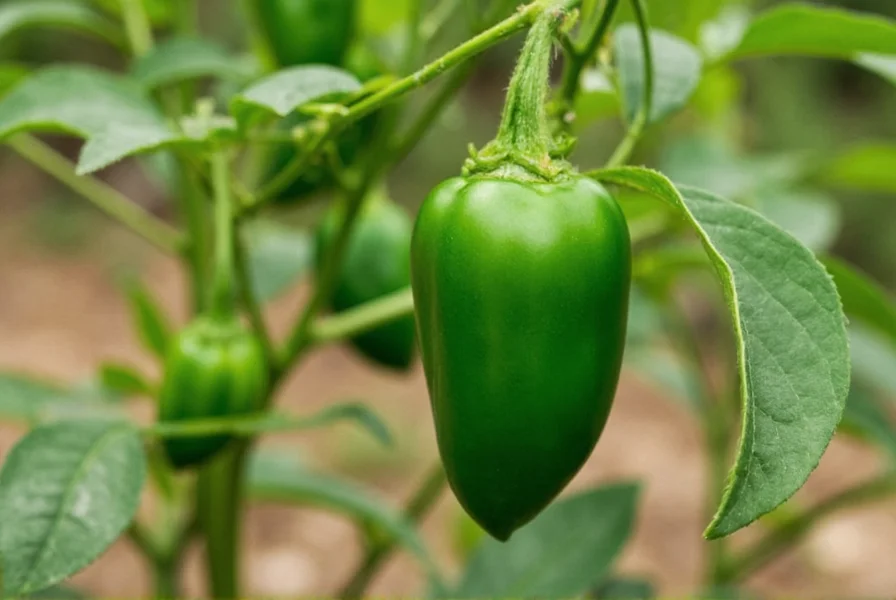The best time to pick jalapeño peppers is when they reach 2-4 inches in length, have a firm, glossy texture, and display consistent coloration. For traditional green jalapeños, harvest when fully green but before red streaks appear, typically 70-80 days after planting. For red jalapeños, wait until they turn completely red on the plant. The ideal harvesting window occurs when peppers feel firm but not hard to the touch and show no signs of shriveling.
Knowing precisely when to pick jalapeño peppers makes all the difference between mediocre and exceptional flavor in your dishes. As a gardener with decades of pepper-growing experience, I've learned that harvesting timing directly impacts not only taste but also heat level and shelf life. Whether you're growing jalapeños in your backyard garden or containers on your patio, understanding the visual and tactile indicators of ripeness ensures you get the most from your plants.
Visual Indicators of Jalapeño Ripeness
Successful harvesting begins with recognizing the visual cues that signal your jalapeños are ready. These indicators vary depending on whether you prefer green or red peppers:
| Ripeness Stage | Color | Size | Surface Texture |
|---|---|---|---|
| Early Harvest | Pale green | 1-2 inches | Smooth but thin-walled |
| Optimal Green | Vibrant dark green | 2-4 inches | Glossy, firm skin |
| Transition Stage | Green with red streaks | 3-4 inches | Slightly less glossy |
| Full Red Ripeness | Bright to deep red | 3-4 inches | Duller sheen, thicker walls |
When determining how to tell when jalapeños are ripe, focus first on color consistency. Fully green jalapeños should have no yellowing or browning. As peppers mature toward red, they'll develop characteristic streaks before turning completely red. The size matters less than firmness and color uniformity—some varieties naturally grow larger than others.

Timing Factors for Harvesting Jalapeños
Several timing elements influence when to pick jalapeño peppers:
Days After Flowering
Jalapeños typically mature 50-65 days after flowers appear on the plant. Most gardeners find their first harvest ready approximately 70-80 days after transplanting seedlings outdoors. Track flowering dates to anticipate your harvest window.
Seasonal Considerations
Early season jalapeños often have thinner walls and milder heat. Mid-season peppers typically offer the best balance of flavor and heat. Late-season jalapeños that experience cooler temperatures frequently develop more pronounced heat levels. In regions with short growing seasons, you may need to harvest earlier to avoid frost damage.
Climate Impact on Ripening
Temperature directly affects jalapeño development. Consistent daytime temperatures between 70-85°F (21-29°C) create ideal conditions. Extreme heat (above 90°F/32°C) can cause peppers to ripen faster but may reduce overall yield. Cooler temperatures slow ripening but often increase capsaicin production, resulting in hotter peppers.
How Harvesting Time Affects Flavor and Heat
The moment you decide when are jalapeños ready to pick significantly influences their culinary properties:
Green vs. Red Jalapeños
Green jalapeños offer a bright, grassy flavor with moderate heat. As peppers ripen to red, their flavor becomes sweeter and more complex while heat levels increase by approximately 20-30%. Fully red jalapeños contain more capsaicin—the compound responsible for heat—as well as higher concentrations of vitamins and antioxidants.
Capsaicin Development Timeline
Capsaicin production increases as jalapeños mature. Peppers harvested early contain less heat, while those left to ripen longer develop more intense spiciness. Interestingly, the white pith surrounding the seeds contains the highest concentration of capsaicin, so harvesting technique affects perceived heat level regardless of ripeness stage.

Proper Harvesting Technique
Knowing when to pick jalapeño peppers is only half the battle—proper harvesting technique preserves plant health and fruit quality:
Cutting vs. Pulling
Always use sharp scissors or pruning shears to cut jalapeños from the plant, leaving about ¼ inch of stem attached. Never pull peppers off by hand, as this can damage the plant's fragile branches and reduce future yields. The clean cut promotes faster healing and minimizes disease risk.
Harvesting Frequency
Check plants every 2-3 days during peak season. Regular harvesting encourages continued production—jalapeño plants will stop producing new flowers if mature fruit remains on the plant too long. Morning is generally the best time to harvest when temperatures are cooler and peppers are most hydrated.
Post-Harvest Handling
What you do after picking affects how your jalapeños perform in the kitchen:
Immediate Care
After harvesting, gently wipe peppers dry with a clean cloth. Avoid washing until ready to use, as moisture accelerates spoilage. Store at room temperature for immediate use (1-2 days) or in the refrigerator's crisper drawer for up to two weeks.
Ripening Off the Plant
Unlike some fruits, jalapeños won't continue ripening significantly once picked. Peppers harvested with red streaks may develop slightly more color at room temperature, but fully green jalapeños won't turn red off the plant. For best results, allow peppers to reach their desired color on the vine.
Common Harvesting Mistakes to Avoid
Even experienced gardeners sometimes make these jalapeño harvesting errors:
- Harvesting too early - Picking when peppers are smaller than 2 inches yields underdeveloped flavor
- Leaving peppers too long - Overripe jalapeños become soft, develop wrinkles, and may split
- Ignoring weather conditions - Harvest before expected heavy rain to prevent splitting
- Using dull tools - Crushes stems rather than making clean cuts
- Handling roughly - Causes bruising that leads to premature spoilage
By paying attention to these harvesting details, you'll maximize both your jalapeño yield and quality throughout the growing season. Remember that each plant may produce peppers at slightly different rates, so check your entire crop regularly rather than harvesting all at once.
Frequently Asked Questions
Can you eat jalapeños right after picking?
Yes, jalapeños are safe to eat immediately after harvesting. In fact, they're at their peak freshness and flavor right off the plant. Simply rinse under cool water before using. Some chefs recommend letting freshly picked jalapeños rest at room temperature for 24 hours to allow flavors to mellow slightly, but this isn't necessary for safety.
Do jalapeños get hotter the longer they stay on the plant?
Generally yes—jalapeños develop more capsaicin (the compound that creates heat) as they mature. Green jalapeños harvested early tend to be milder, while those left to ripen to red typically have 20-30% more heat. Environmental stressors like water scarcity or temperature extremes can also increase heat levels regardless of ripeness stage.
What happens if I pick jalapeños too early?
Harvesting jalapeños before they reach 2 inches in length results in underdeveloped flavor and thinner walls. While still edible, early-harvested peppers lack the full complexity of mature jalapeños and have lower capsaicin levels. The plant may also redirect energy to produce fewer new flowers if immature fruit is consistently removed.
How often should I harvest jalapeños from my plant?
Check your jalapeño plants every 2-3 days during peak season. Regular harvesting every 5-7 days encourages continued production, as plants stop producing new flowers when mature fruit remains too long. Morning is generally the best time to harvest when temperatures are cooler and peppers are most hydrated.
Can you harvest jalapeños after the first frost?
No, frost damages jalapeño plants and fruit. Harvest all mature peppers before the first expected frost. If frost is imminent, you can pick nearly ripe jalapeños (with some red coloration) and allow them to finish ripening indoors at room temperature, though they won't develop as much color or heat as those ripened on the plant.











 浙公网安备
33010002000092号
浙公网安备
33010002000092号 浙B2-20120091-4
浙B2-20120091-4